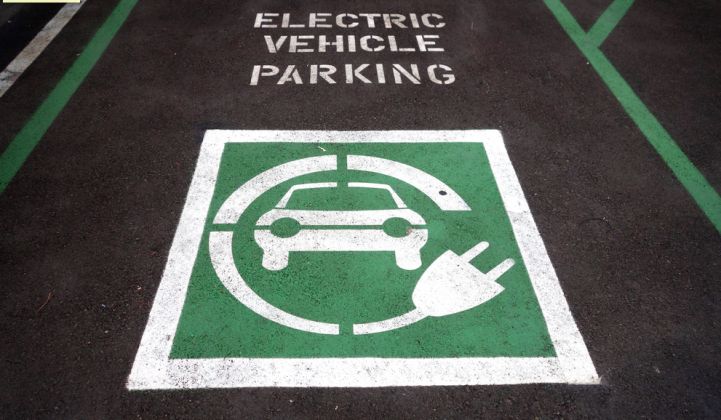California’s three major investor-owned utilities are already rolling out nearly $200 million in electric-vehicle charging infrastructure for apartments, workplaces and disadvantaged communities.
Now they’re seeking permission to spend $1 billion more over the next five years -- a move they say is needed to help the state meet its EV targets and carbon reduction goals, even as the Trump administration threatens to cut federal support for these efforts.
In new filings with the California Public Utilities Commission, Southern California Edison, Pacific Gas & Electric and San Diego Gas & Electric have laid out plans for a combination of fast-charging stations, electric-bus and -truck charging systems, and new rates and incentives.
The biggest, from Southern California Edison, envisions raising $570 million over five years, which will increase ratepayers' bills by an average of 0.5 percent. The rollout would include 50 fast-charging ports, capable of charging EVs in under 30 minutes, at five clusters in the utility’s territory; charging stations for electric buses and trucks, as well as airport and cargo-handling vehicles; rebates to encourage new residential charging stations; and rate incentives to encourage EV owners to charge during off-peak hours.
That’s a much bigger rollout than SCE’s $22 million Vehicle Grid Integration program approved last year. That program will deploy 1,500 Level 2 chargers at workplaces and multifamily housing sites, and includes an emphasis on deploying third-party EV charging equipment and network providers.
SDG&E, which previously won approval to spend $45 million to deploy 3,500 chargers, is also proposing a much larger rollout funded by $244 million over five years. The plan includes charging stations for airport and seaport vehicles, delivery trucks, taxis, park-and-ride sites and up to 90,000 residences, as well as special rates to incentivize EV owners to charge at times of low energy prices and plentiful solar and wind power.
And PG&E, which late last year won approval for a $130 million rollout at apartments and workplaces, the country’s biggest utility-led EV charging program to date, is now seeking $253 million more for an expanded list of EV projects. Those include $211 million for "make-ready" electric infrastructure for medium- to heavy-duty and off-road fleets, as well as $22 million for EV fast-charging stations.
California’s utilities have been busy making EV-charging investment plans since early 2015, when the CPUC lifted a four-year ban on utilities investing in the market. That move was seen as necessary to unlock a critical source of investment in the electrical charging infrastructure needed to help the state meet its ambitious EV goals.
California has been leading the country in electric-vehicle adoption, with some 235,000 registered in the state as of December. But it will need more charging infrastructure investment to help it reach its goal of 1 million zero-emission vehicles by 2020 and 1.5 million ZEVs by 2025.
It has also placed a heavy burden on EVs to help it attain its long-range greenhouse-gas reduction goals, which include the recent decision by the California Air Resources Board to cut carbon emissions to 40 percent below 1990 levels by 2030.
At the same time, CPUC is demanding that utilities make a place for third-party EV charging providers in their plans. It’s done that by limiting utility ownership to the equipment required to bring electricity to each new charging station, rather than owning the EV chargers themselves, and maintaining end-customer choice in terms of which EV charging providers they work with.
Similar guidelines are likely to apply to the new funding requests coming from utilities, particularly for charging infrastructure aimed at the larger consumer market. For example, PG&E’s $22 million fast-charger plan calls for spending to “complement state and privately funded fast charger deployments with new electric infrastructure,” rather than owning the stations themselves -- a concept that PG&E floated, and the CPUC rejected, last year.
There are plenty of private parties seeking to fill the fast-charger gap in California. For example, Tesla has more than 50 of its direct current (DC) Supercharger stations installed across California, although these are designed to charge only the company’s own EVs.
EVgo, the charging company sold by NRG Energy last summer, has plans to build up to 200 fast-charging locations in California under a controversial legal settlement with the state. And startup ChargePoint announced last month that it’s using California Energy Commission grants to install 70 new fast-charging stations along the state’s highways, with installations expected to start in 2017 and be completed in late 2018.
Meanwhile, charging for fleet vehicles such as buses, delivery trucks and airport tractors is an important niche market, with longstanding projects underway to reduce air pollution and increase fuel efficiency at sites in California. Electric bus startup Proterra recently raised $140 million to scale up production at its Los Angeles County factory, and the Los Angeles Air Force Base has replaced its entire fleet with plug-in EVs.
Work vehicles like these make up only a small fraction of the state's overall EV goals. But as the Natural Resources Defense Council noted in a Monday blog post, electrifying trucks, buses, port equipment, forklifts and other vehicles that move people and goods in bulk will "provide substantial public health benefits by displacing dirty diesel pollution."
***
Join GTM for actionable conversations on the future of electricity in our nation's most innovative state. California's Distributed Energy Future 2017 will be held in San Francisco, March 8-9. Learn more here.



